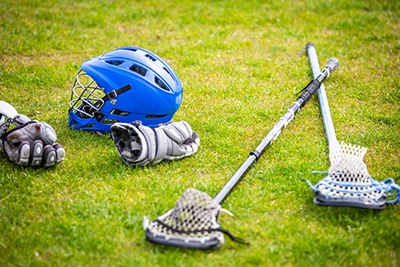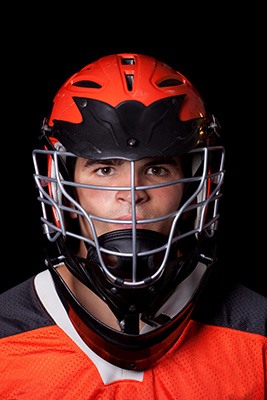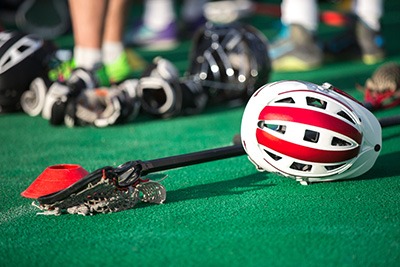Playing lacrosse requires the right equipment to ensure safety and comfort. Knowing the correct size for each piece of equipment is essential for a successful game.
Lacrosse equipment sizing can be tricky, but with the correct information and guidance, it's easy to find the perfect fit. This article will discuss how to size lacrosse equipment such as helmets, gloves, complete sticks, and more.
We'll also provide helpful sizing charts and tips to ensure you get the best fit possible.
More...
Take Away Key Points:
Essential equipment for lacrosse players
Playing lacrosse requires a few crucial pieces of equipment to ensure the safety and enjoyment of the game. The most critical equipment for lacrosse players are a stick, helmet, mouthguard, cleats/turf shoes, gloves, pads, balls, and a bag.
The lacrosse stick has two main parts: the head and the lacrosse shafts. The head is where the ball is caught and thrown from, while the lacrosse shaft is used to control the ball. Therefore, choosing a complete stick that fits your size and playing style is important. Additionally, you can select a soft mesh for the pocket as it is easier for beginning players and youth defensemen.
Helmets are required for boys' lacrosse but optional for girls'. They use a chin strap for optimal fit.
Goggles are recommended for all players as extra protection against eye injuries. In addition, mouthguards help protect teeth and gums from impact during play.
Cleats or turf shoes provide traction on grass or turf surfaces, while gloves protect from lacrosse sticks and balls and provide warmth in colder weather. Pads such as shoulder pads, arm guards, rib pads, and gloves can also be worn for additional protection during play. Lastly, a bag must carry all your gear to and from practice or games.
Having the right equipment and appropriate stick lengths is essential for any lacrosse player looking to enjoy their time playing lacrosse safely and successfully. With this equipment in hand, you'll be ready to take on any opponent!

Lacrosse glove sizing
Regarding lacrosse, the glove is an essential piece of equipment. You must get the right size for your hand to maximize protection and performance.
Lacrosse gloves come in a range of sizes, from 8 inches for youth players to 13 inches for adults. To determine the best size for you, consider your age, weight, height, and hand size.
Size | Age | Weight (lbs) | Height (in) | Glove Length (in) |
|---|---|---|---|---|
XS | 6 | 50 | Under 46 | 8" |
S/M | 8-10 | 50-70 | 46-54 | 10" |
M | 11 | 81-105 | 37-47 | 12" |
L | 13 | 106-150 | 48-68 | 13" |
XL | Over 16 | 160+ | 68"+ | 14" |
Lacrosse stick length
Lacrosse is a popular sport that requires players to have the right equipment.
One of the most important pieces of equipment is the lacrosse stick, which comes in different sizes depending on the lacrosse player's position.
Attack and midfielders need a short stick measuring between 40 and 42 inches, while defensive and midfield players should try a long lacrosse shaft length between 52 and 72 inches. Goalies require an even longer stick length, measuring 60 inches or more.
When choosing a lacrosse stick length, it's important to consider your height and arm length and your position on the field.
The head of the lacrosse stick should be 10 inches long for all positions, but the attack stick length is made of shorter sticks than those used by other players.
Additionally, ensuring you have enough room to maneuver with your lacrosse stick when playing is important.
When it comes to shaft length material, this is more of a personal preference.
Position | Height Range | Stick Length |
|---|---|---|
Attacker/Midfielder | Under 4' | 30" |
Attacker/Midfielder | 4' - 4'4" | 36" |
Attacker/Midfielder | 4'4" - 5' | 40" |
Attacker/Midfielder | 5' - 5'4" | 44" |
Attacker/Midfielder | Over 5'4" | 48" |
Defense/Goalie | All Heights | 52-72" |
Lacrosse helmet sizing chart

Regarding the lacrosse helmet size chart, it is important to get the right fit for your head. The best way to do this is to measure your head circumference with a soft string and then compare that measurement with the sizing chart provided by the helmet manufacturer. Different manufacturers may have various sizing charts, so make sure you use the correct one.
It is also important to adjust the helmet correctly for a proper fit. However, most helmets are designed as one-size-fits-all and can be adjusted accordingly.
1. Youth helmets
The appropriate youth helmet size is determined by measuring around the circumference of the head just above the eyebrows and ears, then referencing the size chart below.
Inches | Helmet Size |
|---|---|
20"–21" | Youth Small |
21"–22" | Youth Medium |
22"–23" | Youth Large |
2. Adult helmets
Adult helmets come in two sizes: Medium and Large. The size should be adjusted using the back plate adjustment system to ensure that your helmet fits snugly and comfortably.
To determine which adult helmet size is right for you, use a tape measure around your head, starting at the forehead and continuing along your temples and the back.
Reference the chart below to find your proper size.
Inches | Helmet Size |
|---|---|
20" – 21¾" | Adult Medium |
24" and larger | Too large - not recommended |
Lacrosse shoulder & chest pads sizing
When finding the right size for adult shoulder pads for lacrosse, you should take a few important measurements.
First, to ensure your shoulder pads fit correctly and provide the best protection, you'll need to measure your chest circumference around the nipple line, shoulder width from outside tip to outside tip, and height.
Then, use this information to match the appropriate size in the chart below.
1. Shoulder pads size chart
Size | Chest | ShoulderWidth | Height |
|---|---|---|---|
XS | 32-34” | 36” | 5'5"-5'9" |
S | 34-36" | 38" | 5'7"-5'11" |
M | 36-38" | 40" | 5'9"-6'1" |
L | 38-40" | 42" | 6'0"-6'4" |
When fitting your shoulder pads, ensure they sit comfortably on your shoulders without slipping down or up. The straps should be tight enough that they don't move around but not so tight that it's uncomfortable. In addition, the shoulder and arm pads need to offer appropriate arm protection during stick checks.
It's vital to ensure your shoulder pads fit correctly so you can play confidently, knowing you're protected. If you have any questions about sizing or fitting your shoulder pads, reach out to an expert at a sporting goods store near you.
2. Chest pads sizing guide
When choosing the right size lacrosse chest padding, it's crucial to get the right fit.
The following size chart will help you determine the best fit for your body type and position on the field.
Size | Age Group | Weight | Height |
|---|---|---|---|
XS: 22-25" | 5-7 years old | 50 lbs or less | under 46" |
S/M: 25-29" | 8-10 years old | 50-70 lbs | 46" - 54" |
M: 30-34" | 11-13 years old | 70 - 90 lbs | 54" - 62" |
LG: 34 - 36” | 14+ years old | 90+ lbs | 62” + |
XL: 37+ | 16+ years old | 100+ lbs | 65"+ |
Lacrosse attire sizing
When it comes to lacrosse attire, sizing is an important factor. Therefore, ensuring that the equipment and apparel you're wearing fit properly for comfort and safety is essential.
The first step in finding the right size is to measure yourself accurately. To do this, you will need a soft string or measuring tape to measure your chest, waist, hips, and inseam. Once you have these measurements, you can use them as a guide when looking at sizing charts for lacrosse clothing.
For other pieces of lacrosse clothing, such as jerseys and shorts, size charts vary from brand to brand but generally follow standard sizing conventions such as small, medium, large, etc. Again, it's important to double-check the manufacturer's website for specific sizing information before making a purchase.
FAQs
How do I know my lacrosse helmet size?
To find the right size for your lacrosse helmet, you'll need to measure your head circumference with a soft tape measure or string. To do this, measure around your head just above your ears, from front to back. Once you have this measurement in inches, you can use it as a guide when looking at the manufacturer's website sizing charts.
Are lacrosse boots true to size?
Lacrosse boots are typically accurate in size, but it's always a good idea to double-check the manufacturer's sizing chart and measure your feet before making a purchase. Different manufacturers may have slightly different sizing charts, so check their websites for specific details.
How to size youth lacrosse equipment?
When sizing youth lacrosse equipment, it's important to ensure you get the right size for your child.
Generally, sizes range from X-Small to Large and are typically listed according to a numerical system (i.e., 0-7).
The best way to ensure you get the right size is to measure your child with a soft string or measuring tape. The tape will help you cut any equipment to a personal preference and into a straight line. Then, measure their height from head to toe, waist circumference, and chest circumference.
What size lacrosse stick for a 14-year-old?

The size of the lacrosse stick is determined by the player's position and height.
Generally, attackers and midfielders need a shorter stick measuring between 40 and 42 inches, while defensive and midfield players should try a longer lacrosse shaft with a minimum length of 52 to 72 inches.
How should lacrosse helmets fit?
When selecting a lacrosse helmet, finding one that fits properly is key. A helmet should fit snugly and securely without any gaps or loose areas.
Should lacrosse gloves be tight?
Lacrosse gloves should fit snugly but not too tight.
The best way to tell if your lacrosse gloves fit snugly is to try them on and ensure they don't slip around while moving your hands.
Also, check the glove's backhand for a secure fit; it should not feel too tight and must allow enough airflow so that your hands do not sweat or become uncomfortable during play.
Summary
Here is a summary list of how to size lacrosse equipment:
- Measure your body type before purchasing
- Be sure to try on and test equipment at home before using it outside
- Refer to manufacturer sizing charts online
- Seek advice from the knowledgeable staff at local lacrosse stores
- Make sure your equipment fits correctly by not being too tight or loose
- Ensure that you are safe and protected on the field with comfortable, secure lacrosse equipment
Although your coach is a great starting point to determine specific equipment, here is a list of recommended equipment needs for lacrosse players participating in youth, high school, or NCAA-level play:
- Complete Sticks: Lacrosse sticks, also called crosse, are the primary weapon on the field. It should be lightweight and durable. Choosing a soft mesh pocket with a hard mesh blend will offer many benefits. Beginners may also opt for traditional pockets and build confidence along the way.
- Pads: Pads protect you from hard shots, checks, pokes, and falls. Look for pads that are comfortable and provide adequate protection.
- Helmet: A helmet is essential to protect your head from impacts while playing lacrosse and offers greater protection. Make sure it fits properly and securely.
- Gloves: Gloves provide more protection against lacrosse sticks and balls while also allowing you to maintain a good grip on your lacrosse stick. It's best to go for higher-end gloves that offer more durability for most players.
- Cleats: Cleats are important for providing traction on the field so you can sprint and make sharp turns without slipping.
- Mouthguard: Mouthguards protect your teeth from contact with other players' sticks or balls and any accidental falls or collisions.
- Apparel: Clothing explicitly designed for lacrosse helps keep you cool during long games by wicking away sweat and moisture.
Conclusion
Ultimately, finding a comfortable fit that provides safety and protection is the key to how to size lacrosse equipment. Most leagues require specific equipment needs, so you need to do your research.
Take the time to measure your body type, try on equipment at home before using it outside, and consult the lacrosse size chart or local lacrosse store staff if you're unsure. Then, with the right size, you can ensure you're ready for game day!
